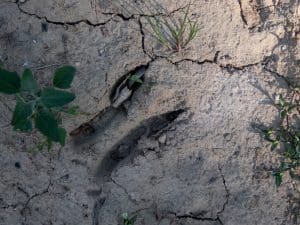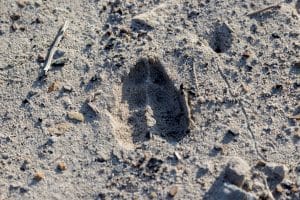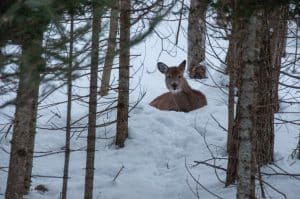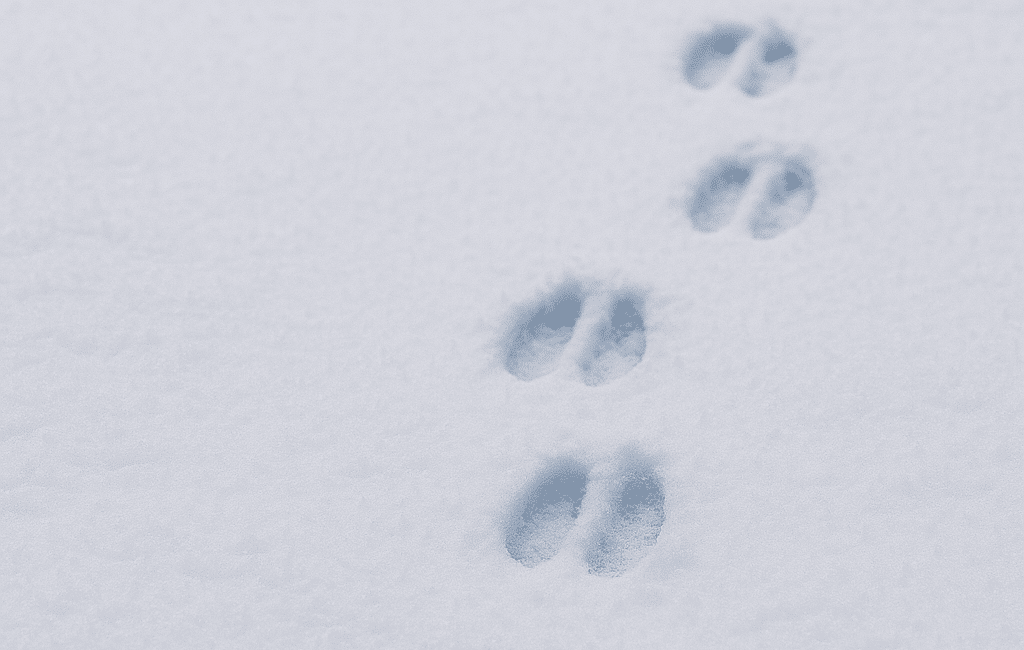Most hunters walk right past some of the most valuable intel in the woods. They’re focused on finding fresh rubs or the next hot scrape, but they’re missing critical information literally under their feet. Deer tracks can tell you more about the animal you’re after than almost any other sign, yet they rarely get the attention they deserve. Learning to read deer tracks isn’t complicated, but it does require you to slow down and pay attention. The payoff is worth it, though. When you understand what you’re looking at, those impressions in the mud or snow become a roadmap to your next buck.
Basics of Deer Tracks
What Do Deer Tracks Look Like – Understanding Hoof Structure

Deer hooves are split, creating a two-toed print that’s unmistakable once you know what to look for. Each hoof consists of two main toes (cleaves) that come to a point at the front. Behind these main toes, you’ll sometimes see dewclaw impressions—two small dots that only show up when the ground is soft or the deer is running.
The shape of white tailed deer tracks is roughly heart-shaped when the toes are together, but this changes depending on the deer’s speed and the terrain. On hard ground, you might only see the very tips of the hooves. In mud or snow, you’ll get the full impression including depth and splay.

Key Features to Look For
Size matters when you’re evaluating tracks. A mature buck’s front track typically measures 3 to 4 inches long. Does and younger bucks leave smaller impressions, usually in the 2.5 to 3 inch range. The depth tells you about weight—heavier deer sink deeper into soft ground.
Pay attention to how the track is structured. The two halves might splay apart or stay close together. They could point straight ahead or angle inward or outward. Some deer have chips missing from their hooves, creating distinctive marks you can learn to recognize. These individual characteristics are like fingerprints, and they’re incredibly useful when you’re trying to track a specific animal.
Types of Deer Tracks
Walking Tracks
Walking tracks are what you’ll see most often. The deer is calm and moving at a normal pace. The hooves typically stay fairly close together, though mature bucks over 200 pounds often show some natural splay in their front tracks even when walking. The stride length is consistent and the tracks appear deliberate rather than scattered.
Running Tracks
Running tracks look completely different. The hooves splay wide apart as the deer pushes off and lands. You’ll often see debris kicked forward from the track, and the impression might show signs of sliding. Dewclaws frequently register when deer run, leaving those telltale marks behind the main hooves. The stride length increases dramatically, and the pattern becomes more erratic.
Bedding Tracks
Bedding tracks aren’t really tracks at all, but they’re worth understanding. When a deer beds down, it leaves an oval depression in the leaves or snow. You might see tracks leading into and out of the bed, but the bed itself is a flattened area roughly 3 to 4 feet long. Fresh beds still hold warmth, and the compressed vegetation hasn’t started to spring back yet.

Feeding Tracks
Feeding tracks show up in concentrated areas where deer have been browsing. Multiple impressions overlap as the deer shifts position to reach different browse. The tracks might show a meandering pattern as the animal moves from one food source to another. During early season whitetail deer hunting, you’ll find these near agricultural fields and food plots.

Identifying Deer Tracks
What to Look for in Different Conditions
What do deer tracks look like in different conditions? That’s where things get interesting. In prime tracking medium—fresh mud or wet snow—you’ll see every detail. The sharp edges of the hoof, the texture of the pad, even fine lines around the perimeter show up clearly. This is when you can really study the track and commit its characteristics to memory.
Dry ground is tougher. You might only see scuff marks or disturbed leaves. Experienced trackers can follow a running deer through the forest just by reading these subtle disturbances, but it takes practice. Sometimes you won’t see an actual print at all, just evidence that something heavy moved through the area.
Deep snow presents its own challenges. The track might punch through several inches, obscuring the fine details. You’ll get a general size and shape, but individual characteristics disappear. Crusty snow that partially supports a deer’s weight creates broken tracks that are hard to interpret.
How Soil Type Affects Tracks
Each type of soil affects how tracks appear. Clay holds details beautifully but dries hard and can last for weeks. Sandy soil gives you size and basic shape but loses fine details quickly. Loamy soil is ideal for tracking—it captures detail without being so sticky that it distorts the print.
Factors Affecting Track Appearance
Weather Impact on Track Aging
Weather transforms tracks rapidly. A fresh track in mud might have sharply defined edges and visible texture. After a day, those edges start to round off. Rain accelerates this process, washing away definition and making even relatively fresh tracks look old. Sun-dried mud creates a baked impression that can last for weeks but loses all moisture-related freshness indicators.
Snow tracks age differently. Fresh snow compresses cleanly under a deer’s weight, leaving crisp impressions. But wind fills tracks with drifted snow, sun creates a glazed surface, and temperature fluctuations cause the edges to melt and refreeze. A track from last night might be unrecognizable by afternoon if conditions are right.
Best Places to Find Clear Tracks
The ground itself plays a huge role in what you can learn from a track. Soft mud near creek crossings captures everything, making these spots ideal for studying individual deer. Field edges after rain become natural track traps where you can see exactly which deer are using which routes. Hardpack trails in the woods might show nothing more than a slight depression, even from a mature buck.
Measuring Deer Tracks
Quick Field Methods
You don’t need fancy equipment to measure deer tracks effectively. Your hand works perfectly. Close your fingers together and measure the track width in finger widths. A “four finger” track typically indicates a buck over 200 pounds. This quick field method gives you actionable information without carrying extra gear.
Taking Precise Measurements
For more accurate assessment, focus on these key measurements:
- Track length: Measure from the back of the track to the front point (mature buck = 3.5+ inches)
- Track width: Measure across the widest part when toes are splayed (mature buck = 3+ inches)
- Stride length: Distance from center of one track to center of the next on the same side (walking mature buck = 20-24 inches)
- Tracking width: Distance between left and right tracks (reveals body structure differences)
The tracking width—the distance between the left and right tracks—also matters. Bucks carry more weight in their chest and shoulders, creating a wider front track spread. Their rear tracks typically fall slightly inside the front tracks. Does have narrower chests and often place their rear tracks slightly outside their front tracks, though younger deer frequently step their hind feet into their front tracks.
What Deer Tracks Tell You
Reading Movement Patterns
Whitetail deer tracks reveal patterns you can use to predict future behavior. A buck traveling the same route repeatedly creates a recognizable trail. If you find his distinctive track pattern heading into a bedding area in the morning and leaving in the evening, you’ve got valuable intelligence about his daily movement.
Track direction matters more than most hunters realize. Deer use their noses constantly, and they prefer to move with the wind in their favor. A line of deer track direction heading into thick cover with the wind at the deer’s back tells you this animal is bedding security-conscious. Tracks approaching a field from downwind of likely danger zones show a deer that’s using the terrain and wind together for safety.
Determining Track Freshness
Fresh tracks tell you whether you’re looking at recent activity or ancient history:
- Very fresh (0-6 hours): Moisture visible in impression and on displaced soil, sharp edges, loose dirt chunks
- Half-day old: Track still moist but surface soil drying, edges beginning to soften
- One day old: Everything dry, edges noticeably rounded, dirt chunks cemented to ground
- Multiple days old: Significant weathering, definition lost, may be partially filled with debris
Regional Differences in Track Appearance
Mule deer track characteristics differ slightly from whitetails. Mule deer tend to be larger animals in many parts of their range, creating proportionally larger tracks. Their habitat often includes rockier terrain, which affects track appearance. When spotting and stalking mule deer, you’ll encounter tracks in diverse conditions from alpine meadows to desert hardpan.
Buck vs Doe Tracks
Understanding the Key Differences
Learning to distinguish buck vs doe tracks gives you a significant advantage. The front tracks are your best indicator. Mature bucks develop permanent splay in their front hooves from years of carrying heavy body weight and antlers. This isn’t from running or soft ground—it’s structural. The hooves simply spread apart from constant pressure.
A buck’s track pattern reveals his body structure. Wide front track spread, narrow rear track spread. The rear tracks fall inside the front tracks when he’s walking normally. This reflects his build: massive chest and shoulders, narrower hindquarters. Some mature bucks leave a track so distinctive you can identify them individually. One might have hooves that toe out, another might show a chip in his hoof, and a third might have tips that hook in a particular direction.
Doe Track Characteristics
Does show the opposite pattern. Their chest is narrower relative to their hips, and their tracks reflect this. Rear tracks fall slightly outside the front tracks during casual walking. The front tracks are smaller and show less splay even in soft ground. Does don’t develop the permanent hoof spread that mature bucks do, regardless of age.
Size alone isn’t foolproof for distinguishing sex. A large mature doe can leave tracks similar to a young buck. This is where you need to look at the full picture: track size, track pattern, stride length, and the spacing between left and right tracks. Put all these pieces together and you’ll make accurate assessments most of the time.
Signs of Deer Activity Beyond Tracks
Combining Track Evidence with Other Sign
Tracks work best when combined with other indicators:
- Fresh tracks leading to recently worked scrapes
- Tracks through creek crossings with fresh droppings nearby
- Multiple track sizes indicating several mature bucks using the area
- “Wedgies” (mud chunks trapped between splayed hooves) on hard ground
Some bucks create what trackers call “wedgies”—chunks of mud that get trapped between their permanently splayed hooves and drop off between steps. These distinctive shapes are dead giveaways that a mature buck just passed through. They’re easier to spot than the tracks themselves sometimes, especially on hard ground where track definition is poor.
Population Dynamics from Track Patterns
Multiple track patterns in one area reveal population dynamics. Three different sizes of large tracks tell you three different mature bucks are using this location. Consistent patterns over time show this isn’t random wandering—these bucks have established this as part of their core area. That’s valuable information when you’re trying to figure out where to score a deer this season.
Final Thoughts
Deer tracks won’t lie to you. A rub might be from last year. A scrape might be a young buck trying to act tough. But fresh tracks tell you exactly what was there and approximately when. They show you travel routes, they reveal individual animals, and they point you toward bedding and feeding areas with precision that other sign can’t match.
The hunters who consistently tag mature bucks aren’t necessarily the ones with the most gear or the best spots. They’re often the ones who slow down enough to read what the deer are telling them. Tracks are a conversation if you learn the language.
Start paying attention to every track you cross. Take photos of distinctive prints. Follow tracks to see where they lead. Check field edges after rain and study what you find. Compare fresh tracks to day-old tracks to week-old tracks. This hands-on education beats any article or video you’ll ever watch.
Your next big buck is leaving his signature all over your hunting area right now. The question is whether you’re taking the time to read it. Get out there and put your eyes on the ground. The story is already written—you just need to learn how to read it.
Per our affiliate disclosure, we may earn revenue from the products available on this page. To learn more about how we test gear, click here.



